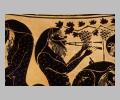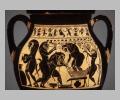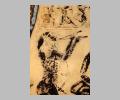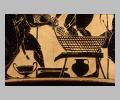| Collection: | Martin von Wagner Museum, University of Würzburg |
| Summary: | Side A: silens making wine. Side B: Dionysos and silens dancing. Shoulder: Dionysos seated, with silens and nymphs. Lid: animal frieze. |
| Ware: | Attic Black Figure |
| Painter: | Attributed to the Amasis Painter |
| Context: | Probably from Vulci |
| Date: | ca. 530 BC - ca. 520 BC |
| Dimensions: | H. 0.375 m. |
| Primary Citation: | |
| Shape: | Amphora |
| Beazley Number: | 310451 |
| Region: | Etruria |
| Period: | Archaic |
Date Description:
The vase belongs to the mature phase, about 530 BC.
Condition:
The glaze is worn in some areas; parts of the surface are damaged and have been repainted.
Decoration Description:
Side A: Scene of winemaking. Five silens (satyrs) are involved in various aspects of the production of wine. Hairy ithyphallic silens are picking grapes and making wine. To the far right, facing left, a silen picks a bunch of grapes from a vine, which extends from the right of the picture into the center, supported by two vine poles. In front of him, a silen treads grapes in a basket, as another pours in bunches of grapes. The silen treading grapes faces left and is bending down to look at the grapes, lifting his left arm that hold or grab the tendrils or the branches of the vine. The treading basket in on a trestle platform which slopes gently towards a spout, thus collecting the liquid oozing through the basket. The juice then drains into a pithos (earthenware store vessel) sunk into the ground, of which the top is visible. On the ground under the trestle a black jug (sort of hydria) and further to the left a black kantharos. The third silen is facing right and carrying the bunches of grapes in a recipient from which they are being shot into the treading basket. A fourth silen standing to right plays double pipes, making music to accompany the work, and a fifth to the left pours water from a hydria into a large black pithos, from which only the half is visible.
Above, along the top of the panel, a miniature frieze with five satyrs and four nymphs or maenads dancing around Dionysos. Dionysos is seated on a stool facing right, with a drinking horn in his hand, while silens and nymphs dance on either side of him. The silens and nymphs move with exaggerated gestures, lifting arms and legs. Five of them are coming from left to the center, to Dionysos, and the other four are coming from right to left, dancing in front of Dionysos. The silens are naked and ithyphallic and the nymphs are dressed in decorated peplos and crowned with ivy.
Side B: Dionysos and satyrs dancing. Dionysos and four silens are dancing, playing music and -one might say- tasting the new wine. A bearded Dionysos, dressed in chiton and himation and crowned with ivy, dances in the middle of the scene. In his left hand he holds three short sprigs of ivy branches and in his right a kantharos lowered to receive wine from a silen who is pouring it out for him from a wineskin. The silen turns his mask-like face, looking round at us proudly. At left of this central group, a silen playing the aulos (double flute). At right, behind the figure of Dionysos, two others hasten up, their arms round each other's necks, holding drinking horns; the one behind drinking.
The small upper frieze has five silens and four nymphs dancing. Dressed and with the same characteristics as on side A, their dancing seems to get wilder. The silens and the nymphs form two lines: one, coming from left to right, including three silens and two nymphs, and the other, coming from right to left, with two and two. Both lines are led by a silen and meet each other.
Purple used for the hair and tails of the silens, for the flower and on the himation of Dionysos; white, which has largely gone, was for female flesh (of the nymphs), whilst a yellowish color was applied for the stream of wine flowing from the trading platform into the pithos.
The whole vase is consecrated to Dionysos. He is present in some way on both sides of the vessel. Beazley also thought in an unitary conception of the entire vase and identified the scenes on this vase as a single subject, the vintage, the obverse showing the manufacture of the wine and the reverse showing the first taste of the finished product.
The black figure vintage scenes depict two activities: harvesting the grapes and processing them, picking and treading. Most illustrate one or the other, but several show both activities which suggests that the processing of the grapes was thought to take place near the vineyard. However, this is the earliest vase on which picking and treading grapes are depicted together in the same scene, and despite of the scenes of the same type, it seems likely that depictions of the two processes developed independently.
There are many ancient representations of the vintage and sometimes the vintners are mortals, more often there are silens or satyrs. The association between satyrs and wine on Attic-black figure vases takes two basic forms. They carry wine or they are involved in its production, either picking grapes or treading them. In each of these contexts, Dionysos is sometimes included and sometimes not. Satyrs are also sometimes shown drinking or holding a drinking-vessel, but these scenes are very much the exception rather than the rule. In this vase we have everything. Besides, the representation of Dionysos dancing is very rare. Rare too to see the silens pouring actually wine from a wineskin for Dionysos. These details suggest that we are not dealing with a stock. This is the earliest picture in which Dionysos himself joins in the dance, instead of standing motionless amid the tumult and Dionysos dancing is rare in Attic-black-figure.
The silens depicted in this vase are characteristic of the Amasis painter: "Amasean breed". Fat, hairy, and swine-like, with huge necks and alert features; characteristic also is their pose, massive thighs and the shape and attitude of their phalloi. The indication of hairiness on the silens' body is fairly rare. The female companions in the dancing of this special silens are considered by Hedreen to be nymphs, instead of the almost generally accepted maenads, who he retains not to be the partners of the silens. The Amasis painter was one of the first Attic vase painters to specialize in Dionysiac scenes.
Above the foot a reserved zone filled with a zone of double rays. On both handles where they are anchored to the body, there is a reserved body, filled with vertical zig-zag lines. At handle root a palmette within a reserved patch.
Lid: On the lid, siren between sphinxes, between lions, between a siren and a swan. A frieze with different kind of animals following a pattern. There are real and fantastic animals mixed together.
Shape Description:
Amphora of type A with lid, but special model. The amphora is abnormal both in its general shape and its details, such as the form of the foot and the decoration of the handles. Only
Collection History:
From the Feoli Collection
Sources Used:
Other Bibliography:





